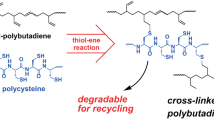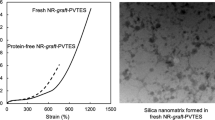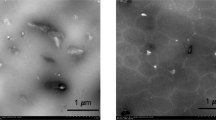Abstract
STORAGE hardening in natural rubber, which is of considerable industrial interest, has been ascribed to the crosslinking of carbonyl groups present in the rubber chain1. Supporting evidence is that the crosslinking reaction can be prevented or accelerated by the addition of monofunctional or difunctional amines, respectively. These observations may be explained if the monofunctional amine is regarded as condensing with, and hence destroying, the carbonyl group, whereas the difunctional reagent is capable of reaction with carbonyl groups on separate chains, thus effecting a crosslink. The ability of dimedone (5,5-dimethylcyclohexane-1,3-dione) to inhibit the crosslinking reaction led to the conclusion that the groups were aldehydic1.
This is a preview of subscription content, access via your institution
Access options
Subscribe to this journal
Receive 51 print issues and online access
$199.00 per year
only $3.90 per issue
Buy this article
- Purchase on Springer Link
- Instant access to full article PDF
Prices may be subject to local taxes which are calculated during checkout
Similar content being viewed by others
References
Sekhar, B. C., J. Polymer Sci., 48, 133 (1960).
Sekhar, B. C., Fourth Rubb. Tech. Conf., London, 1 (1962).
March, J., Advanced Organic Chemistry, 334 (McGraw-Hill New York, 1968).
Adams, R. M., and Vander Werf, C. A., J. Am. chem. Soc., 72, 4368 (1950).
Sekhar, B. C., Malaysia Natural Rubber—New presentation processes, (Rubber Research Institute of Malaya, 1971).
Heterocyclic compounds with three and four membered rings (edit. by Weissberger, A.), Part 1, 628 (Interscience, New York, 1964).
Flory, P. J., and Leutner, F. S., J. Polymer Sci., 3, 880 (1948).
Sekhar, B. C., Proc. Nat. Rubb. Res. Conf. Kuala Lumpur, 512 (1960).
Anderson, and Winterstein, J. org. Chem., 28, 605 (1963).
Author information
Authors and Affiliations
Rights and permissions
About this article
Cite this article
BURFIELD, D. Epoxy groups responsible for crosslinking in natural rubber. Nature 249, 29–30 (1974). https://doi.org/10.1038/249029a0
Received:
Revised:
Issue Date:
DOI: https://doi.org/10.1038/249029a0
This article is cited by
-
Impact of non-rubber components on the branching structure and the accelerated storage hardening in Hevea rubber
Journal of Rubber Research (2020)
-
Contrastive Study on Properties of Acid and Microorganisms Coagulated Natural Rubber during Accelerated Storage
Journal of Rubber Research (2018)
-
Direct imaging and elemental mapping of microgels in natural rubber particles
Colloid and Polymer Science (2005)
Comments
By submitting a comment you agree to abide by our Terms and Community Guidelines. If you find something abusive or that does not comply with our terms or guidelines please flag it as inappropriate.



